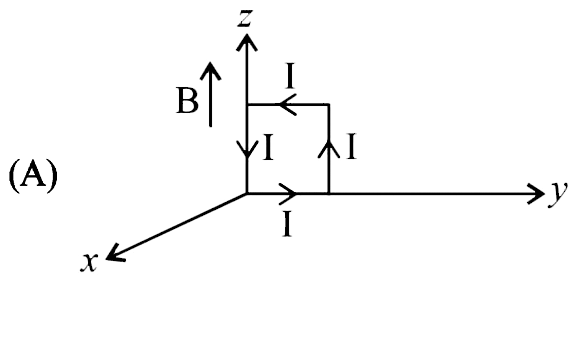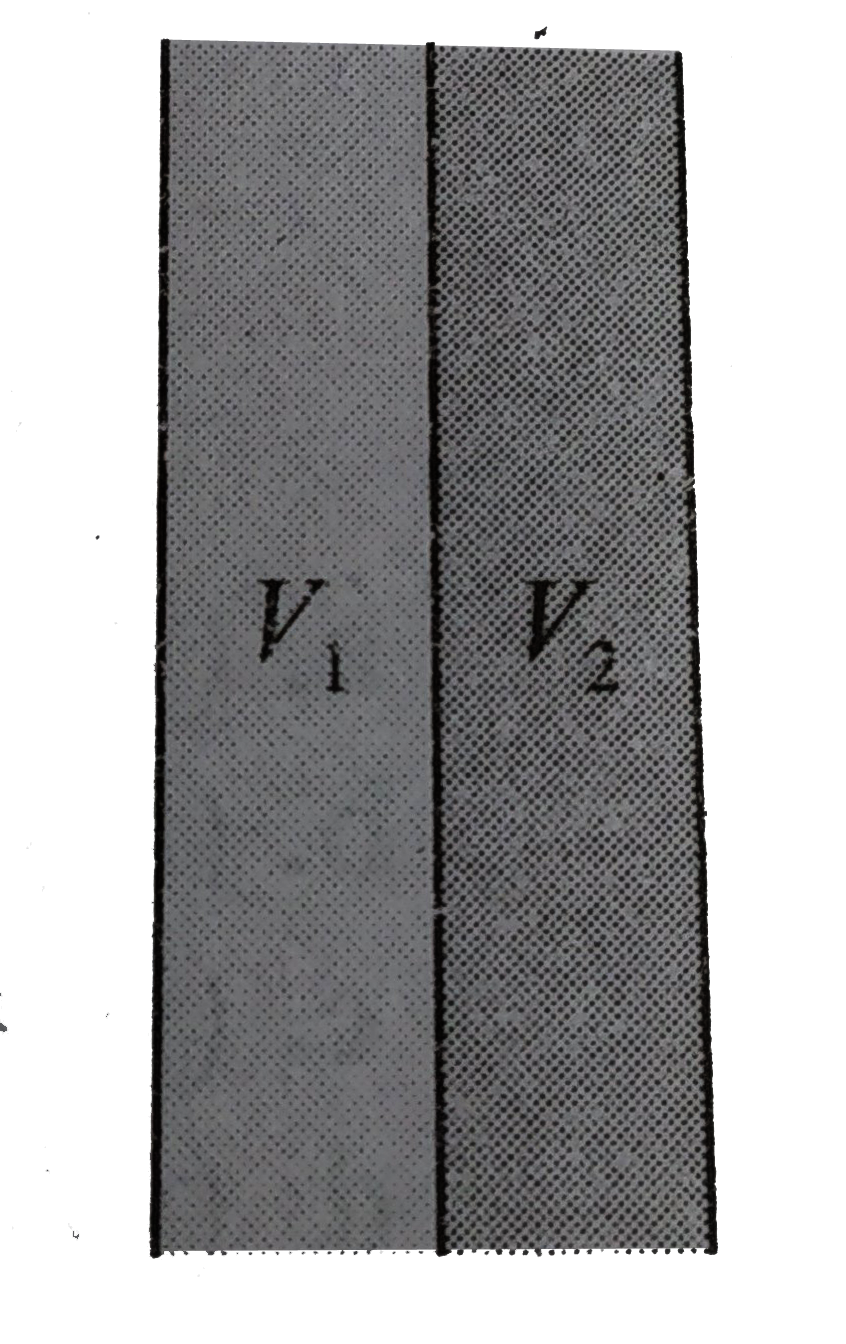Consider a uniform electric field in the direction. The potential is a constant.
in all space
for any x for a given z
for any y for a given z
on the x-y plane for given z
The correct Answer is:B, C, D
To solve the problem, we need to analyze the behavior of electric potential in the presence of a uniform electric field directed in the ^z direction.
1. Understanding the Electric Field:
- A uniform electric field in the ^z direction means that the electric field vector E can be represented as E=E^z, where E is a constant magnitude.
- Electric field lines point in the direction of the field, indicating that the potential decreases in the direction of the field.
Hint: Remember that electric field lines indicate the direction of force on a positive charge.
2. Electric Potential and Its Relation to Electric Field:
- The electric potential V is related to the electric field by the equation:
E=−∇V
- This means that the potential decreases as you move in the direction of the electric field.
Hint: The gradient of the potential gives the electric field direction and magnitude.
3. Equipotential Surfaces:
- Equipotential surfaces are surfaces where the electric potential V is constant. For a uniform electric field in the ^z direction, these surfaces are perpendicular to the electric field lines.
- Since the electric field is in the z direction, the equipotential surfaces will be horizontal planes at different heights z.
Hint: Equipotential surfaces are always perpendicular to electric field lines.
4. Analyzing the Options:
- Option 1: "In all space" - This option is incorrect because the potential varies with height z. Different planes at different z values will have different potentials.
- Option 2: "For any x for a given z" - This option is correct. For a fixed z, the potential does not depend on x or y since it is constant on that horizontal plane.
- Option 3: "For any y for a given z" - This option is also correct for the same reason as Option 2.
- Option 4: "On the xy plane for a given z" - This option is correct as well since all points on the same z plane have the same potential.
Hint: Evaluate each option based on the behavior of potential in relation to the electric field direction.
5. Conclusion:
- The correct options are 2, 3, and 4. The potential is constant for any x and y at a fixed z, and on the xy plane for a given z.
Final Answer:
- The correct options are: 2, 3, and 4.
- A uniform electric field in the ^z direction means that the electric field vector E can be represented as E=E^z, where E is a constant magnitude.
- Electric field lines point in the direction of the field, indicating that the potential decreases in the direction of the field.
- The electric potential V is related to the electric field by the equation:
E=−∇V
- This means that the potential decreases as you move in the direction of the electric field.
- Equipotential surfaces are surfaces where the electric potential V is constant. For a uniform electric field in the ^z direction, these surfaces are perpendicular to the electric field lines.
- Since the electric field is in the z direction, the equipotential surfaces will be horizontal planes at different heights z.
- Option 1: "In all space" - This option is incorrect because the potential varies with height z. Different planes at different z values will have different potentials.
- Option 2: "For any x for a given z" - This option is correct. For a fixed z, the potential does not depend on x or y since it is constant on that horizontal plane.
- Option 3: "For any y for a given z" - This option is also correct for the same reason as Option 2.
- Option 4: "On the xy plane for a given z" - This option is correct as well since all points on the same z plane have the same potential.
- The correct options are 2, 3, and 4. The potential is constant for any x and y at a fixed z, and on the xy plane for a given z.
- The correct options are: 2, 3, and 4.
Topper's Solved these Questions
- BOOK - NCERT EXEMPLAR ENGLISHCHAPTER - ELECTROSTATIC POTENTIAL AND CAPACITANCEEXERCISE - Very short type question5videos
ELECTROSTATIC POTENTIAL AND CAPACITANCE
- BOOK - NCERT EXEMPLAR ENGLISHCHAPTER - ELECTROSTATIC POTENTIAL AND CAPACITANCEEXERCISE - Short Answer Type Question5videos
ELECTROSTATIC POTENTIAL AND CAPACITANCE
- BOOK - NCERT EXEMPLAR ENGLISHCHAPTER - ELECTROSTATIC POTENTIAL AND CAPACITANCEEXERCISE - Long Answer Type Question10videos
ELECTROSTATIC POTENTIAL AND CAPACITANCE
- BOOK - NCERT EXEMPLAR ENGLISHCHAPTER - ELECTROMAGNETIC WAVESEXERCISE - LONG ANSWER5videos
ELECTROMAGNETIC WAVES
- BOOK - NCERT EXEMPLAR ENGLISHCHAPTER - MAGNETISM AND MATTER EXERCISE - All Questions24videos
MAGNETISM AND MATTER
Similar Questions
A solid metal cube of edge length 2 cm is moving in a positive y-direction at a constant speed of 6 m/s. There is a uniform magnetic field of 0.1 T in the positive z-direction. The potential difference between the two faces of the cube perpendicular to the x-axis, is :
View SolutionA charged particle begins to move from the origin in a region which has a uniform magnetic field in the x-direction and a uniform electric field in the y-direction. Its speed is v when it reaches the point (x, y, z). Then, v will depend
View Solution
Knowledge Check
- Question 1 - Select One
Assertion : In a uniform electric field electrons move in the opposite direction of electric field.
Reason : This is because of the negative charge of an electron.AIf both assertion and reason are true and reason is the correct explanation of assertion.BIf both assertion and reason are true but reason is not the correct explanation of assertion.CIf assertion is true but reason is false.DIf both assertion and reason are false. - Question 2 - Select One
Consider a uniform electric field E=3×103ˆiN/C. (a) What is the flux of this field through a square of 10 cm on a side whose plane is parallel to the yz plane ? (b) What is the flux through the same square if the normal to its plane makes a 60∘ angle with the x-axis ?
A10NC−1m2B20NC−1m2C30NC−1m2D40NC−1m2
(A) : An electron moving with uniform velocity enters uniform magnetic field perpendicularly and then a uniform electric field in the same direction. Nature of paths followed by electron in both the fields will be same.
(R) : The force applied by magnetic and electric field on electron are in the same direction.View Solution(a) Draw the equipotential surfaces corresponding to a uniform electric field in the z-direction.
(b) Derive an expression for the electric potential at any point along the axial line of an electric dipoleView SolutionIf there is uniform magnetic field of in the positive z direction , in which orientations the loop would be in (i) stable equilibrium and (ii) unstable equilibrium ?



 View Solution
View SolutionAn electron traveling in a uniform electric field passes from a region of potential V1 to a region of higher potential V2. Then
 View Solution
View SolutionIn a uniform electric field if a charge is fired in a direction different from the line of electric field then the trajectory of the charge will be a
View SolutionConsider a uniform electric field E=3×103ˆiN/C. (a) What is the flux of this field through a square of 10 cm on a side whose plane is parallel to the yz plane ? (b) What is the flux through the same square if the normal to its plane makes a 60∘ angle with the x-axis ?
View Solution

